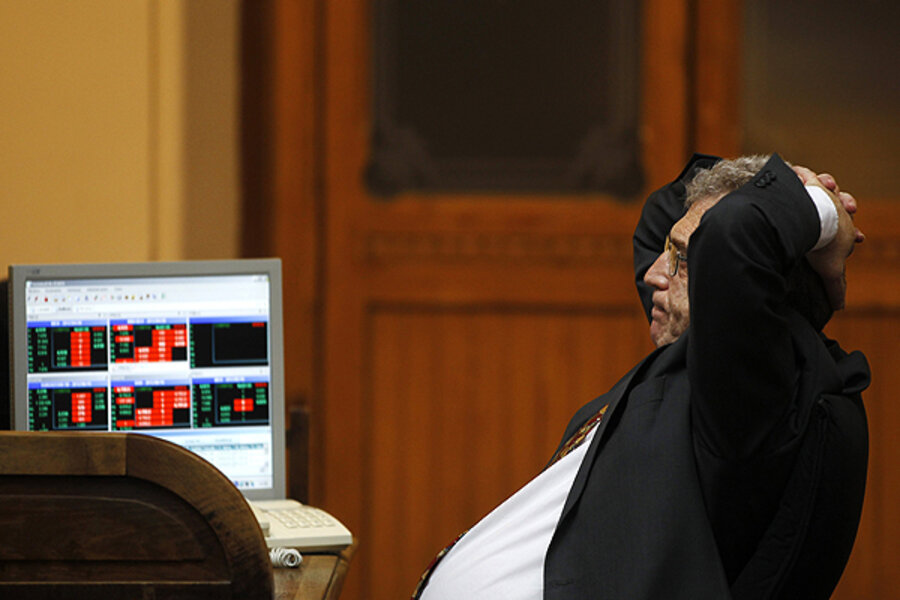European debt: the more things change, the more they stay the same
Loading...
The more things don’t change…the more they remain the same. You can quote us on that.
On the surface, very little changed in the 2 months we were away.
The Dow was about 13,000 in mid-Feb. It’s still about 13,000.
The yield on the 10 year US note was about 2%. No change there either.
The euro was about $1.30. It’s $1.30 today.
Gold is a little lower. Big deal.
But down deeper….did anything more substantial change…evolve…develop?
Apparently not. Back in the winter, the Europeans were pretending to fix Greece. Now they’re pretending to fix Spain.
But wait…here’s something that might be changing…now nobody believes the fixes will stay fixed.
“Europe’s Rescue Plan Falters,” says the front page of The Wall Street Journal.
Yesterday, widely reported was the fact that Spanish banks held more delinquent loans than at any time since 1995. The world seemed to be waking up too to the realization that when you pour bad money after good money you end up with no money.
The ECB’s $1.3 trillion worth of loans to banks was supposed to put a stop to liquidity problems. After all, investors know that borrowers can get more money. The ECB lends to the banks. The banks lend to the governments. You can’t go broke that way. Not as long as the money keeps flowing.
But wait again… “After months of using that cash to buy their government’s debt,” reports the WSJ, “banks in Spain and Italy have little left.”
Let’s look at this more closely.
The banks have a lot of bad debt, left over from the go-go lending mania in the bubble years.
Led by Ireland, the governments bailed them out. But that put the governments themselves in jeopardy. They didn’t have any real money to lend the banks. They had to borrow. They just gave the banks money that they had borrowed themselves. So then investors began to wonder about Ireland, Greece, Portugal, Spain and Italy. And guess what? They found that they were going broke too.
That’s when the central bank came to the rescue. The idea was to bail out the banks and the governments at the same time. The ECB’s LTRO program looked like a winner, for a while. The plan was simple enough: lend the money to the banks; make sure the banks lend to the governments.
You see the problem, don’t you? It was just a variation on the US model of trying to fix a debt problem with more debt. In the US version, the Fed buys US government debt, effectively financing the government with printing press cash. In Europe’s version, the ECB lends to banks…who then lend to, say, Greece. Now, they all have more debt than they can pay.
So now, bond yields are rising again…with Spanish debt back over 6%. And Spanish banks are in worse shape than ever.
Meanwhile, the Italians are staggering under the same kind of weight. In order to get financing last year, they promised to balance the budget next year. But now next year is getting close and a balanced budget is still far away. Says Mario Monti…well, maybe the year after!
You go, Mario…keep spending…keep borrowing…and tell your friends at the ECB to keep printing…
So what’s changed?
Nothing. And it’s going to keep not changing until it can’t go on any longer.
You see, dear reader, change is a natural thing. So is the desire to prevent it. And what we’re seeing now is a natural struggle between the Great Correction — which wants to eliminate debt…and the Great Blundering Reflation — in which the feds desperately try to add to the world’s debt supply.
Why are the feds so keen to add debt? They’re not really. What they want to do to is to prevent change. And the only things they’ve got to work with are brute force…counterfeit money…and debt.
But even the USA is scheduled to enter a phase of European-style austerity. Beginning next on Jan. 1st, a combination of tax hikes and spending cuts should grip America and force it into something the newspapers are calling “Taxmaggedon.”
In Greece, …debtors kill themselves…children go hungry…the unemployed threaten insurrection.
In Spain, mobs attack banks…half of all youths are unemployed…and the banks face huge losses from bad debt.
So far, America has avoided those scenes of desperation. But unless Congress takes action to deny what it has promised, like Mario Monti did yesterday, the Great Correction is about to get even greater. Tax rates are scheduled to go up. Automatic spending cuts are scheduled to take deficits down. These are the cans that Congress kicked down the road last year. The Bush/Obama tax cuts will expire in 2013. And — because Congress was unable to come up with a sensible budget — the axe will fall on government spending too.
What will happen if “taxmaggedon” comes as scheduled? Experts say GDP will fall by 3%. Hey, that would put it in negative territory.
And the recovery? Over. Finito. Kaput. And unemployment? Up. House prices? Down.
But wait…will the feds allow such a thing?
No, probably not. They will try to block it. Congress will kick the can again. Tax rates will rise…but not as much as they are supposed to rise. Spending will be trimmed…around the edges…but not seriously.
And then — when the economy and stock market take another dive, as they did in August of 2010 and again in September of 2011 — the Fed will announce another program of QE.
If there is any real change — a real Great Correction, in other words — it will be over their dead bodies.






